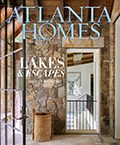Classic Beauty
A Buckhead home undergoes a sensitive renovation that honors the past, yet reflects the present.






Having increased their brood and outgrown their former home in Ansley Park, a young couple set their sights on a larger, architecturally significant residence in Buckhead. They had grand plans for the property, including removing the roof and adding a second story, but called architect D. Stanley Dixon straightaway before they purchased it. “As I drove up to the house, I immediately realized it was the work of James Means,” Dixon explains, referring to Atlanta’s 20th-century master of colonial American architecture.
Knowing this, Dixon insisted they update the house in other ways—such as adding a lime wash instead of white paint to the exterior. His artisans applied this most generously under the eaves, creating the effect of ages of rain erosion. Taking cues from Virginia’s historic Gunston Hall, he also added an octagonal portico, plus symmetrical wings on the back of the home, dormers to light upper hallways and two new staircases to connect the downstairs living spaces with private quarters above.
Taking a page from Means’ playbook, Dixon incorporated reclaimed materials—from antique bricks to crown glass windows—at every turn, creating a seamless marriage of old and new. Historically sensitive detailing—which included intricate trimwork, a slate roof, egg-and-dart moulding, unlacquered brass hardware, restoration glass and Chippendale railings—was so immaculate that Dixon’s firm received a Shutze Award for the project from the Institute of Classical Architecture and Art in 2011. Gracious landscaping was achieved at the hands of the equally esteemed John Howard of Howard Design Studio.
For the interiors, the homeowners returned to Liz Williams, who had outfitted their previous home when they were first married. She brought in softness with a breezy, blue-green scheme, tempered by subtle touches of pink. Incorporating a few key furnishings from the couple’s former abode, she reupholstered several pieces and added luxurious wall coverings for depth and interest.
Allowing the architectural design process to evolve over time was perhaps one of the project’s biggest boons, as not rushing the interior design allowed it to unfold in a beautiful way. “Often, we don’t have the luxury of waiting 18 weeks for orders, but in this case, we were able to hold out for some great pieces, such as those from Holland & Company and Niermann Weeks,” Williams notes. In fact, it was a unique hall table from MacRae that set the decorating plan in motion. “We didn’t want a table that would be too formal on the brick floor, but because it’s the first thing you see from the front door, it had to be special,” she says.
It was those types of touches that fostered the marriage of historic precedent with current-day elegance. “By layering architectural interest, we referenced history even stronger than before, but we also made a house that lives like people do today,” says Dixon. The owners got the comfortable family house they desired, where no rooms are off limits. And as this young family—and their home—has grown, they’ve found room to enjoy it all.
ARCHITECTURE D. Stanley Dixon, D. Stanley Dixon Architect, 2300 Peachtree Rd., Suite C101, Atlanta 30309. (404) 574-1430; dsdixonarchitect.com
INTERIOR DESIGN Liz Williams, Liz Williams Interiors, LLC, 690 Miami Circle, Suite 700, Atlanta 30324. (404) 816-9868; lizwilliamsinteriors.com
FLORAL DESIGN Holly Bryan Floral & Botanical Design. (404) 664-8750; hollybryandesign.com














